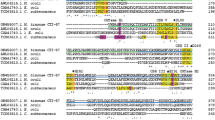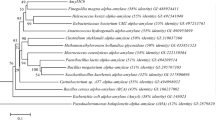Abstract
We cloned and expressed the gene for an intracellular α-amylase, designated AmyB, from the hyperthermophilic bacterium Thermotoga neapolitana in Escherichia coli. The putative intracellular amylolytic enzyme contained four regions that are highly conserved among glycoside hydrolase family (GH) 13 α-amylases. AmyB exhibited maximum activity at pH 6.5 and 75°C, and its thermostability was slightly enhanced by Ca2+. However, Ca2+ was not required for the activity of AmyB as EDTA had no effect on enzyme activity. AmyB hydrolyzed the typical substrates for α-amylase, including soluble starch, amylose, amylopectin, and glycogen, to liberate maltose and minor amount of glucose. The hydrolytic pattern of AmyB is most similar to those of maltogenic amylases (EC 3.2.1.133) among GH 13 α-amylases; however, it can be distinguished by its inability to hydrolyze pullulan and β-cyclodextrin. AmyB enzymatic activity was negligible when acarbose, a maltotetraose analog in which a maltose residue at the nonreducing end was replaced by acarviosine, was present, indicating that AmyB cleaves maltose units from the nonreducing end of maltooligosaccharides. These results indicate that AmyB is a new type exo-acting intracellular α-amylase possessing distinct characteristics that distinguish it from typical α-amylase and cyclodextrin-/pullulan-hydrolyzing enzymes.







Similar content being viewed by others
References
Ballschmiter M, Fütterer O, Liebl W (2006) Identification and characterization of a novel intracellular alkaline α-amylase from the hyperthermophilic bacterium Thermotoga maritima MSB8. Appl Environ Microbiol 72:2206–2211
Bibel M, Brettl C, Gosslar U, Kriegshauser G, Liebl W (1998) Isolation and analysis of genes for amylolytic enzymes of the hyperthermophilic bacterium Thermotoga maritima. FEMS Microbiol Lett 158:9–15
Boel E, Brady L, Brzozowski AM, Derewenda Z, Dodson GG, Jensen VJ, Petersen SB, Swift H, Thim L, Woldike HF (1990) Calcium binding in α-amylases: an X-ray diffraction study at 2.1-Å resolution of two enzymes from Aspergillus. Biochemistry 29:6244–6249
Bok J-D, Yernool DA, Eveleigh DE (1998) Purification, characterization, and molecular analysis of thermostable cellulases CelA and CelB from Thermotoga neapolitana. Appl Environ Microbiol 64:4774–4781
Bradford M (1976) A rapid and sensitive method for the quantification of microgram quantities of protein utilizing the principle of protein-dye binding. Anal Biochem 72:248–254
Bronnenmeier KA, Kern A, Liebl W, Staudenbauer WL (1995) Purification of Thermotoga maritima enzymes for the degradation of cellulosic materials. Appl Environ Microbiol 61:1399–1407
Cha HJ, Yoon HG, Kim YW, Lee HS, Kim JW, Kweon KS, Oh BH, Park KH (1998) Molecular and enzymatic characterization of a maltogenic amylase that hydrolyzes and transglycosylates acarbose. Eur J Biochem 253:251–262
Chhabra S, Parker KN, Lam D, Callen W, Snead MA, Mathur EJ, Short JM, Kelly RM (2001) β-mannanases from Thermotoga species. Methods Enzymol 330:224–238
Chhabra SR, Shockley KR, Ward DE, Kelly RM (2002) Regulation of endo-acting glycosyl hydrolases in the hyperthermophilic bacterium Thermotoga maritima grown on glucan- and mannan-based polysaccharides. Appl Environ Microbiol 68:545–554
Chhabra SR, Shockley KR, Conners SB, Scott KL, Wolfinger RD, Kelly RM (2003) Carbohydrate-induced differential gene expression patterns in the hyperthermophilic bacterium Thermotoga maritima. J Biol Chem 278:7540–7552
Conners SB, Montero CI, Comfort DA, Shockley KR, Johnson MR, Chhabra SP, Kelly RM (2005) An expression-driven approach to the prediction of carbohydrate transport and utilization regulons in the hyperthermophilic bacterium Thermotoga maritima. J Bacteriol 187:7267–7282
Conners SB, Mongodin EF, Johnson MR, Montero CI, Nelson KE, Kelly RM (2006) Microbial biochemistry, physiology, and biotechnology of hyperthermophilic Thermotoga species. FEMS Microbiol Rev 30:872–905
Dipple R, Boos W (2005) The maltodextrin system of Escherichia coli: metabolism and transport. J Bacteriol 187:8322–8331
Duffaud GD, McCutchen CM, Leduc P, Parker KN, Kelly RM (1997) Purification and characterization of extremely thermostable β-mannanase, β-mannosidase, and α-galactosidase from the hyperthermophilic eubacterium Thermotoga neapolitana 5068. Appl Environ Microbiol 63:169–177
Fox JD, Robyt JF (1991) Miniaturization of three carbohydrate analyses using a microsample plate reader. Anal Biochem 195:93–96
Gabelsberger J, Liebl W, Schleifer KH (1993) Cloning and characterization of β-galactoside and β-glucoside hydrolyzing enzymes of Thermotoga maritima. FEMS Microbiol Lett 109:131–137
Henrissat B (1991) A classification of glycosyl hydrolases based on amino acid sequence similarities. Biochem J 280:309–316
Janecek S (1994) Parallel β/α-barrels of alpha-amylase, cyclodextrin glycosyltransferase and oligo-1, 6-glucosidase versus the barrel of β-amylase: evolutionary distance is a reflection of unrelated sequences. FEBS Lett 353:119–123
Janecek S (1995) Close evolutionary relatedness among functionally distantly related members of the (α/β)8-barrel glycosyl hydrolases suggested by the similarity of their fifth conserved sequence region. FEBS Lett 377:6–8
Janecek S (2002) How many conserved sequence regions are there in the α-amylase family? Biologia 57(Suppl 11):29–41
Kim TJ, Kim MJ, Kim BC, Kim JC, Cheong TK, Kim JW, Park KH (1999) Modes of action of acarbose hydrolysis and transglycosylation catalyzed by a thermostable maltogenic amylase, the gene for which was cloned from a Thermus strain. Appl Environ Microbiol 65:1644–1651
Kim TJ, Nguyen VD, Lee HS, Kim MJ, Cho HY, Kim YW, Moon TW, Park CS, Kim JW, Oh BH, Lee SB, Svensson B, Park KH (2001) Modulation of the multisubstrate specificity of Thermus maltogenic amylase by truncation of the N-terminal domain and by a salt-induced shift of the monomer/dimmer equilibrium. Biochemistry 40:14182–14190
Lee HS, Kim MS, Cho HS, Kim JI, Kim TJ, Choi JH, Park C, Lee HS, Oh BH, Park KH (2002a) Cyclomaltodextrinase, neopullulanase, and maltogenic amylase are nearly indistinguishable from each other. J Biol Chem 277:21891–21897
Lee MH, Kim YW, Kim TJ, Park CS, Lim JW, Moon TW, Park KH (2002b) A novel amylolytic enzyme from Thermotoga maritima, resembling cyclodextrinase and α-glucosidase, that liberates glucose from the reducing end of the substrates. Biochem Biophys Res Commun 295:818–825
Liebl W (2001) Cellulolytic enzymes from Thermotoga species. Methods Enzymol 330:290–300
Liebl W, Stemplinger I, Ruile P (1997) Properties and gene structure of the Thermotoga maritima α-amylase AmyA, a putative lipoprotein of a hyperthermophilic bacterium. J Bacteriol 179:941–948
Lim WJ, Park SR, An CL, Lee JY, Hong SY, Shin EC, Kim EJ, Kim JO, Kim H, Yun HD (2003) Cloning and characterization of a thermostable intracellular α-amylase gene from the hyperthermophilic bacterium Thermotoga maritima MSB8. Res Microbiol 154:681–687
McCutchen CM, Duffaud GD, Leduc P, Petersen ARH, Tayal A, Khan SA, Kelly RM (1996) Characterization of extremely thermostable enzymatic breakers (α-1,6-galactosidase and β-1, 4-mannanase) from the hyperthermophilic bacterium Thermotoga neapolitana 5068 for hydrolysis of guar gum. Biotechnol Bioeng 52:332–339
Miller GL (1959) Use of dinitrosalicylic acid reagent for determination reducing sugar. Anal Chem 31:426–428
Miller ES, Parker KN, Liebl W, Lam D, Callen W, Snead MA, Mathur EJ, Short JM, Kelly RM (2001) α-galactosidases from Thermotoga species. Methods Enzymol 330:246–260
Miwa I, Okudo J, Maeda K, Okuda G (1972) Mutarotase effect on colorimetric determination of blood glucose with d-glucose oxidase. Clin Chim Acta 37:538–540
Nelson KE, Clayton RA, Gill SR, Gwinn ML, Dodson RJ, Haft DH, Hickey EK, Peterson JD, Nelson WC, Ketchum KA, McDonald L, Utterback TR, Malek JA, Linher KD, Garrett MM, Stewart AM, Cotton MD, Pratt MS, Phillips CA, Richardson D, Heidelberg J, Sutton GG, Fleischmann RD, Eisen JA, White O, Salzberg SL, Smith HO, Venter JC, Fraser CM (1999) Evidence for lateral gene transfer between archaea and bacteria from genome sequence of Thermotoga maritima. Nature 399:323–329
Nguyen TN, Borges KM, Romano AH, Noll KM (2001) Differential gene expression in Thermotoga neapolitana in response to growth substrate. FEMS Microbiol Lett 195:79–83
Nielsen JE, Borchert TV (2000) Protein engineering of bacterial α-amylases. Biochim Biophys Acta 1543:253–274
Oslancová A, Janecek S (2002) Oligo-1,6-glucosidase and neopullulanase enzyme subfamilies from the α-amylase family defined by the fifth conserved sequence region. Cell Mol Life Sci 59:1945–1959
Park KH, Kim TJ, Cheong TK, Kim JW, Oh BH, Svensson B (2000) Structure, specificity and function of cyclomaltodextrinase, a multispecific enzyme of the α-amylase family. Biochim Biophys Acta 1478:165–185
Park SH, Cha H, Kang HK, Shim JH, Woo EJ, Kim JW, Park KH (2005a) Mutagenesis of Ala290, which modulates substrate subsite affinity at the catalytic interface of dimeric ThMA. Biochim Biophys Acta 1751:170–177
Park TH, Choi KW, Park CS, Lee SB, Kang HY, Shon KJ, Park JS, Cha J (2005b) Substrate specificity and transglycosylation catalyzed by a thermostable β-glucosidase from marine hyperthermophile Thermotoga neapolitana. Appl Microbiol Biotechnol 69:411–422
Parker KN, Chhabra SR, Lam D, Callen W, Duffaud GD, Snead MA, Short JM, Mathur EJ, Kelly RM (2001a) Galactomannanases Man2 and Man5 from Thermotoga species: growth physiology on galactomannans, gene sequence analysis and biochemical properties of recombinant enzymes. Biotechnol Bioeng 75:322–333
Parker KN, Chhabra SR, Lam D, Snead MA, Mathur EJ, Kelly RM (2001b) β-Mannosidase from Thermotoga species. Methods Enzymol 330:238–246
Peist R, Schneider-Fresenius C, Boos W (1996) The MalT-dependent and malZ-encoded maltodextrin glucosidase of Escherichia coli can be converted into a dextrinyltransferase by a single mutation. J Biol Chem 271:10681–10689
Robyt JF, Mukerjea R (1994) Separation and quantitative determination of nanogram quantities of maltodextrins and isomaltodextrins by thin-layer chromatography. Carbohydr Res 251:187–202
Ruile P, Winterhalter C, Liebl W (1997) Isolation and analysis of a gene encoding α-glucuronidase, an enzyme with a novel primary structure involved in the breakdown of xylan. Mol Microbiol 23:267–279
Schumann J, Wrba A, Jaenicke R, Stetter KO (1991) Topographical and enzymatic characterization of amylases from the extremely thermophilic eubacterium Thermotoga maritima. FEBS Lett 282:122–126
Selig M, Xavier KB, Santos H, Schönheit P (1997) Comparative analysis of Embden-Meyerhof and Entner-Doudoroff glycolytic pathways in hyperthermophilic archaea and the bacterium Thermotoga. Arch Microbiol 167:217–232
Stam MR, Danchin EG, Rancurel C, Coutinho PM, Henrissat B (2006) Dividing the large glycoside hydrolase family 13 into subfamilies: towards improved functional annotations of α-amylase-related proteins. Protein Eng Des Sel 19:555–562
Tang SY, Le QT, Shim JH, Yang SJ, Auh JH, Park C, Park KH (2006) Enhancing thermostability of maltogenic amylase from Bacillus thermoalkalophilus ET2 by DNA shuffling. FEBS J 273:3335–3345
Thompson JD, Higgins FG, Gibson TJ (1994) CLSTAL W: improving the sensitivity of progressive multiple sequence alignment through sequence weighting, position-specific gap penalties and weight matrix choice. Nucleic Acids Res 22:4763–4680
Veith B, Zvwelov VV, Lunina NA, Berezina OV, Raasch C, Velikodvorskaya GA, Liebl W (2003) Comparative analysis of the recombinant α-d-glucosidases from the Thermotoga neapolitana and Thermotoga maritima maltodextrin utilization gene clusters. Biocatal Biotransform 21:147–158
Wassenberg D, Schurig H, Liebl W, Jaenicke R (1997) Xylanase XynA from the hyperthermophilic bacterium Thermotoga maritima: structure and stability of the recombinant enzyme and its isolated cellulose-binding domain. Protein Sci 6:1718–1726
Yang SJ, Lee HS, Park CS, Kim YR, Moon TW, Park KH (2004) Enzymatic analysis of an amylolytic enzyme from the hyperthermophilic archaeon Pyrococcus furiosus reveals its novel catalytic properties as both an α-amylase and a cyclodextrin-hydrolyzing enzyme. Appl Environ Microbiol 70:5988–5995
Yernool DA, McCarthy JK, Eveleigh DE, Bok JD (2000) Cloning and characterization of the glucooligosaccharide catabolic pathway β-glucan glucohydrolase and cellobiose phosphorylase in the marine hyperthermophile Thermotoga neapolitana. J Bacteriol 182:5172–5179
Acknowledgments
This study was supported, in part, by the Marine and Extreme Genome Research Center Program of the Ministry of Land, Transportation and Maritime Affairs and by the Korea Research Foundation Grant funded by the Korean Government (MOEHRD; KRF-2007-521-F00056), Republic of Korea.
Author information
Authors and Affiliations
Corresponding author
Additional information
Kyung-Min Park and So-Young Jun contributed equally to the work.
Rights and permissions
About this article
Cite this article
Park, KM., Jun, SY., Choi, KH. et al. Characterization of an exo-acting intracellular α-amylase from the hyperthermophilic bacterium Thermotoga neapolitana . Appl Microbiol Biotechnol 86, 555–566 (2010). https://doi.org/10.1007/s00253-009-2284-1
Received:
Revised:
Accepted:
Published:
Issue Date:
DOI: https://doi.org/10.1007/s00253-009-2284-1




